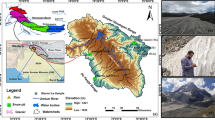Abstract
Ambient PM2.5 samples were taken at 24 h intervals at two sites (Centro and Miravalle) in the city of Guadalajara from January to June 2008. The Centro site is located in the downtown, while the Miravalle site is located in an industrial zone south of the downtown. For both sites the higher concentrations of PM2.5 were between January and May. High correlation coefficients between sulfate, nitrate and ammonium of 0.95, 0.92 and 0.91, respectively, showed low variations in the concentrations of these species in the city. It was estimated that sulfate, nitrate and ammonium represented almost 47% of the PM2.5 mass in June at the Centro site, but in general the contributions in the other months were less than 21%, while at Miravalle this percentage was between 7.7% and 27.6%.


Similar content being viewed by others
References
Báez PA, García MR, Torres BM del C, Padilla HG, Belmont RD, Amador MO, Villalobos-Pietrini R (2007) Origin of trace elements and inorganic ions in PM10 aerosols to the South of Mexico City. Atmos Res 85:52–63
Calvo AI, Pont V, Liousse C, Dupré B, Mariscal A, Zouiten C, Gardrat E, Castera P, Lacaux CG, Castro A, Fraile R (2008) Chemical composition of urban aerosols in Toulouse, France during CAPITOUL experiment. Meteorol Atmos Phys 102:307–323
Cope GW (2004) Exposure classes, toxicants in air, water, soils, domestic and occupational settings. In: Hodgson E (ed) A textbook of modern toxicology. Wiley-Interscience, New Jersey, p 33
Dockery DW, Schwartz J, Spengler JD (1992) Air pollution and daily mortality: association whit particulates and acid aerosols. Environ Res 59:362–373
Fridlind AM, Jacobson MZ (2000) A study of gas-aerosol equilibrium and pH in the remote marine boundary layer during the First Aerosol Characterization Experiment (ACE 1). J Geophys Res 105:17325–17340
Gray HA, Cass GR, Huntzicker JJ, Heyerdahl EK, Rau JA (1986) Characteristics of atmospheric organic and elemental carbon particle concentrations in Los Angeles. Environ Sci Technol 20:580–589
Harrison RM (2004) Key pollutants—airborne particles. Sci Total Environ 334:3–8
Hernández ML, Saldarriaga NH, Carbajal RP, Cosío RR, Esquivel HB (2010) Ionic species associated with PM2.5 in the City of Guadalajara, Mexico during 2007. Environ Monit Asses 161:281–293
Instituto Nacional de Estadística y Geografía (INEGI) (2005) (www.inegi.gob.mx). Accessed 14 May 2009
Ito K, Xue N, Thurston G (2004) Spatial variation of PM2.5 chemical species and sources-apportioned mass concentration in New York City. Atmos Environ 38:5269–5282
Keene WC, Savoie DL (1998) The pH of deliquesced sea-salt aerosol in polluted marine air. Geophys Res Lett 25:2181–2184
Liang J, Jacobson MZ (1999) A study of sulfur oxidation pathways over a range of liquid water contents, pH values, and temperature. J Geophys Res 104:13749–13769
McMurry HP (2000) A review of atmospheric aerosols measurements. Atmos Environ 34:1959–1999
Pope CA III, Dockery DW (2006) Health effects of fine particulate air pollution: lines that connect. J Air Waste Manage Assoc 56:709–742
Programa para el mejoramiento de la Calidad del Aire en la Zona Metropolitana de Guadalajara (PROAIRE) (1997–2001) Secretaría de Medio Ambiente, Recursos Naturales y Pesca. Secretaría de Salud. México
Rattigan VO, Hogrefeb O, Feltona DH, Schwabb JJ, Roychowdhuryb KU, Husainc L, Dutkiewiczc AV, Demerjian LK (2006) Multi-year urban and rural semi-continuous PM2.5 sulfate and nitrate measurements in New York State: evaluation and comparison with filter based measurements. Atmos Environ 40:192–205
Reiss R, Anderson EL, Cross CE, Hidy G, Hoel D, McClellan R, Moolgavkar S (2007) Evidence of health impacts of sulfate- and nitrate-containing particles in ambient air. Inhal Toxicol 19:419–449
Saldarriaga NH, Hernández ML, Ramírez MM, Carbajal RP, Cosío RR, Esquivel HB (2009) Characterization of trace metals of risk to human health in airborne particulate matter (PM2.5) at two sites in Guadalajara, Mexico. J Environ Monit 11:887–984
Sistema Meteorológico Nacional-Comisión Nacional del Agua, SMN-CNA (2008) Accessed 13 May 2009
Tolocka MP, Solomon PA, Mitchel W, Norris GA, Gemmill DB, Wiener RW, Vanderpool RW, Homolya JB, Rice J (2001) East versus west in the US: chemical characteristics of PM2.5 during the winter of 1999. Aerosol Sci Technol 34:88–96
USEPA (1995) Air quality criteria for particle matter, vol II. External review draft EPA/600/AP-95/001b, US Environmental Protection Agency, Office of Research and Development, Washington DC
Walker JT, Whitall RD, Robarge W, Paerl WH (2004) Ambient ammonia and ammonium aerosol across a region of variable ammonia emission density. Atmos Environ 38:1235–1246
Acknowledgments
The authors would like to express their appreciation to Sandra Bravo and Rosalva Cuevas for their collaboration in the analysis of inorganic ions, to Dana Erickson and Winston Smith of the Peace Corps for the revision of this paper and to the Secretaría de Medio Ambiente para el Desarrollo del Estado de Jalisco (SEMADES), for allowing the installment of the equipment in their locations. Special thanks also to Consejo Nacional de Ciencia y Tecnología (CONACyT) for the financial support in this project.
Author information
Authors and Affiliations
Corresponding author
Rights and permissions
About this article
Cite this article
Hernández-Mena, L., Saldarriaga-Noreña, H., Carbajal-Romero, P. et al. Presence of the Most Abundant Ionic Species and Their Contribution to PM2.5 Mass, in the City of Guadalajara, Jalisco (Mexico). Bull Environ Contam Toxicol 85, 632–637 (2010). https://doi.org/10.1007/s00128-010-0140-8
Received:
Accepted:
Published:
Issue Date:
DOI: https://doi.org/10.1007/s00128-010-0140-8




